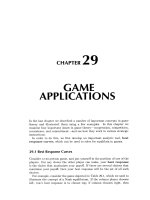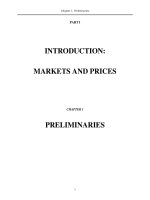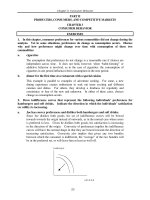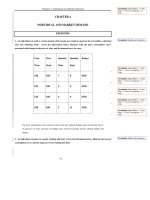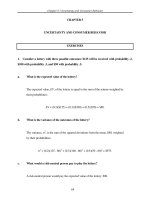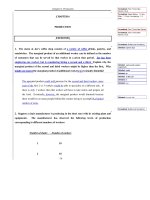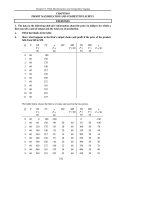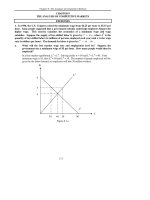Tài liệu Bài tập về Kinh tế vĩ mô bằng tiếng Anh - Chương 13 pdf
Bạn đang xem bản rút gọn của tài liệu. Xem và tải ngay bản đầy đủ của tài liệu tại đây (16.04 KB, 4 trang )
CHAPTER 13
CORPORATE FINANCING
DECISIONS AND EFFICIENT
CAPITAL MARKETS
For this chapter, consider the “concept” questions.
3. a. False. Market efficiency implies that prices reflect all available
information, but it does not imply certain knowledge. Many pieces of
information that are available and reflected in prices are fairly uncertain.
Efficiency of markets does not eliminate that uncertainty and therefore
does not imply perfect forecasting ability.
b. True. Market efficiency exists when prices reflect all available
information. To be efficient in the weak form, the market must
incorporate all historical data into prices. Under the semi-strong form of
the hypothesis, the market incorporates all publicly-available information
in addition to the historical data. In strong form efficient markets, prices
reflect all publicly and privately available information.
c. False. Market efficiency implies that market participants are rational.
Rational people will immediately act upon new information and will bid
prices up or down to reflect that information.
d. False. In efficient markets, prices reflect all available information. Thus,
prices will fluctuate whenever new information becomes available.
e. True. Competition among investors results in the rapid transmission of
new market information. In efficient markets, prices immediately reflect
new information as investors bid the stock price up or down.
4. On average, the only return that is earned is the required return—investors buy
assets with returns in excess of the required return (positive NPV), bidding up
the price and thus causing the return to fall to the required return (zero NPV);
investors sell assets with returns less than the required return (negative NPV),
driving the price lower and thus causing the return to rise to the required
return (zero NPV).
6. Yes, historical information is also public information; weak form efficiency is
a subset of semi-strong form efficiency.
13. Taken at face value, this fact suggests that markets have become more
efficient. The increasing ease with which information is available over the
Internet lends strength to this conclusion. On the other hand, during this
particular period, large-capitalization growth stocks were the top performers.
Value-weighted indexes such as the S&P 500 are naturally concentrated in
such stocks, thus making them especially hard to beat during this period. So, it
may be that the dismal record compiled by the pros is just a matter of bad luck
or benchmark error.
18. The market is often considered to be relatively efficient up to the semi-strong
form. If so, no systematic profit can be made by trading on publicly-available
information. Although illegal, the lead engineer of the device can profit from
purchasing the firm’s stock before the news release on the implementation of
the new technology. The price should immediately and fully adjust to the new
information in the article. Thus, no abnormal return can be expected from
purchasing after the publication of the article. .
19. Under the semi-strong form of market efficiency, the stock price should stay
the same. The accounting system changes are publicly available information.
Investors would identify no changes in either the firm’s current or its future
cash flows. Thus, the stock price will not change after the announcement of
increased earnings.
22. Stock prices should immediately and fully rise to reflect the announcement.
Thus, one cannot expect abnormal returns following the announcement.
